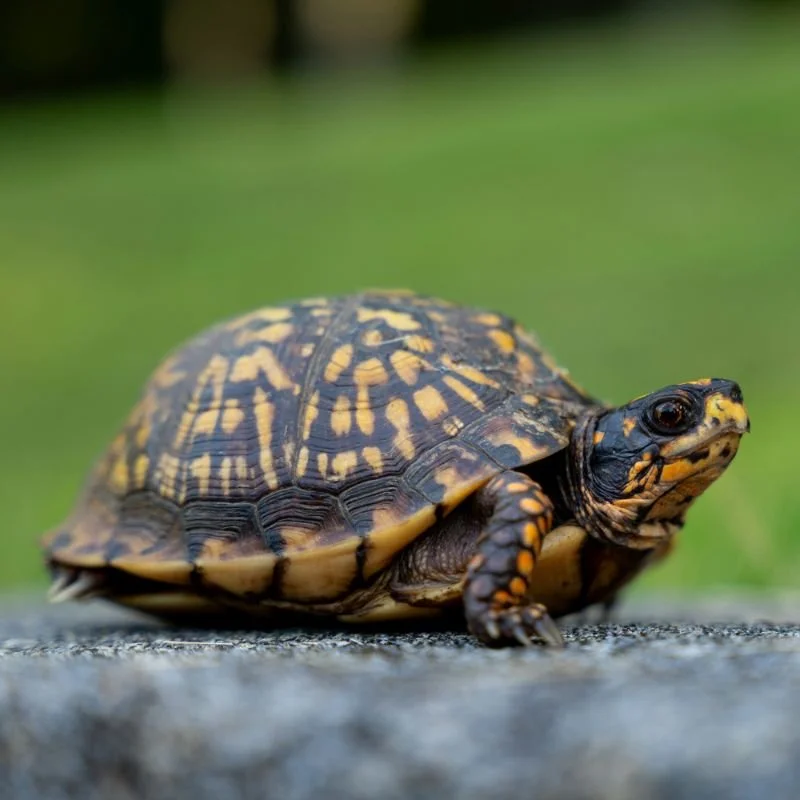What Do Box Turtles Eat in the Wild and at Home
Discover what box turtles eat in nature and captivity. Learn proper diet, feeding schedules, and nutrition tips for healthy, happy turtles.
Ever watched a box turtle munching away and wondered, "What on earth is that little guy eating?" Well, you're not alone! These adorable shelled creatures have quite the appetite, and their dietary needs are way more complex than most people realize. Whether you've just adopted a box turtle or you're simply curious about these fascinating reptiles, understanding their eating habits is like unlocking a secret code to their health and happiness.
Here's the kicker: box turtles are opportunistic omnivores, which basically means they'll eat just about anything that looks tasty and fits in their mouth. But hold your horses! That doesn't mean you can toss them table scraps and call it a day. Knowing what do box turtles eat in the wild and at home is crucial for their survival and well-being. In the wild, they're nature's little garbage disposals, but in captivity, they rely entirely on us to get their nutrition right.
The fascinating thing about these prehistoric-looking critters is how their diet changes with age, seasons, and environment. Young box turtles are like teenagers at a buffet, preferring protein-packed meals, while older turtles tend to go more vegetarian. Talk about a lifestyle change! So, buckle up as we dive deep into the wonderful world of box turtle cuisine.
Understanding Box Turtle Dietary Basics
The Omnivore's Dilemma
Box turtles are true omnivores, and boy, do they take that title seriously! In the grand scheme of reptile dining, they're basically the equivalent of humans who enjoy both a good steak and a fresh salad. This dietary flexibility has helped them survive for millions of years, adapting to various environments and food availability.
Their digestive system is designed to handle both plant and animal matter, equipped with:
A sharp beak for tearing food
Strong jaws for crushing hard items
A relatively long digestive tract for processing vegetation
Beneficial gut bacteria for breaking down cellulose
Age Matters: Dietary Shifts Through Life
Looking at a baby box turtle's diet versus an adult's is like comparing a bodybuilder's meal plan to a yoga instructor's. Here's how it breaks down:
Hatchlings and Juveniles (0-5 years):
70-80% protein
20-30% vegetation
Higher metabolism requires frequent feeding
Growth demands extra calcium
Adults (5+ years):
50-60% vegetation
40-50% protein
Slower metabolism
More selective eating habits
What Do Box Turtles Eat in the Wild and at Home: The Wild Menu
Nature's Buffet: Wild Food Sources
Walking through a box turtle's natural habitat is like strolling through their personal grocery store. These resourceful reptiles have adapted to eat whatever their environment provides, and trust me, they're not picky eaters when hunger strikes!
Protein sources in the wild include:
Earthworms (the filet mignon of turtle food)
Slugs and snails (shells and all!)
Insects like crickets, beetles, and grubs
Small fish in shallow waters
Carrion (yeah, they're not above scavenging)
Bird eggs when they can find them
Small amphibians and baby mice
Plant matter they naturally consume:
Wild berries (blackberries, strawberries, mulberries)
Mushrooms (they somehow know which ones are safe)
Fallen fruits
Leafy greens and grasses
Flower petals and dandelions
Moss and algae
Seasonal Eating Patterns
Just like how we crave hot soup in winter and ice cream in summer, box turtles adjust their diet seasonally:
Spring Menu: After hibernation, they're ravenous! Spring means:
Protein-heavy diet to regain strength
Fresh shoots and new growth
Emerging insects and worms
Early berries and flowers
Summer Feast: The most abundant season offers:
Wide variety of insects
Ripe fruits and berries
Abundant vegetation
Occasional carrion
Fall Preparation: Getting ready for winter means:
Gorging on high-calorie foods
Seeking fruits for energy storage
Eating more to build fat reserves
Reduced activity and appetite as temperature drops
Foraging Behaviors and Techniques
Watching a box turtle hunt is like watching a slow-motion nature documentary. They've got some pretty clever tricks:
The Ambush Method: Sitting perfectly still near ant hills or termite mounds
The Dig and Seek: Using those strong claws to unearth grubs and worms
The Patient Fisher: Waiting by water edges for unsuspecting prey
The Opportunist: Following rain for easy earthworm picking
Creating the Perfect Home Menu
Replicating Natural Diet in Captivity
Trying to recreate a wild diet at home might seem daunting, but it's totally doable with some planning. The key is variety, variety, and did I mention variety? A monotonous diet is not only boring but can lead to nutritional deficiencies faster than you can say "shell rot."
Protein Options for Captive Box Turtles
Live food (the gold standard):
Crickets (gut-loaded for extra nutrition)
Mealworms (in moderation, they're fatty)
Earthworms (pesticide-free only!)
Dubia roaches
Waxworms (occasional treats)
Pinkie mice (for larger turtles)
Commercial options:
High-quality turtle pellets
Freeze-dried insects
Canned insects (rinse first)
Cat food (wet, high-quality, occasional only)
Preparing protein meals:
Dust live insects with calcium powder
Vary protein sources weekly
Remove uneaten portions after an hour
Never feed wild-caught insects (pesticide risk)
Vegetables and Greens: The Plant Paradise
Dark, leafy greens (the daily staples):
Collard greens
Mustard greens
Dandelion greens (pesticide-free)
Turnip greens
Endive
Escarole
Other vegetables (mix it up):
Squash (butternut, yellow, zucchini)
Sweet potato (cooked)
Carrots (shredded or finely chopped)
Bell peppers
Green beans
Peas
What to avoid like the plague:
Iceberg lettuce (nutritionally empty)
Spinach (binds calcium)
Avocado (toxic)
Rhubarb (poisonous)
Fruits: Nature's Candy
Fruits should be treats, not staples. Think of them as dessert:
Safe fruits include:
Berries (strawberries, blueberries, raspberries)
Melons (cantaloupe, honeydew)
Apples (no seeds)
Grapes (halved)
Mangoes
Papaya
Figs
Fruit feeding tips:
Maximum 10-15% of diet
Remove seeds and pits
Chop into bite-sized pieces
Rotate varieties
Watch for diarrhea (too much fruit)
Supplements and Special Nutritional Needs
Calcium: The Shell's Best Friend
Without proper calcium, your turtle's shell could become as soft as a wet cardboard box. Not good! Here's the calcium lowdown:
Calcium supplementation methods:
Dust food with calcium powder 2-3 times weekly
Provide cuttlebone for nibbling
Use calcium with D3 for indoor turtles
Calcium without D3 for outdoor turtles
Vitamin Requirements
Essential vitamins include:
Vitamin A (prevents eye and respiratory issues)
Vitamin D3 (calcium absorption)
Vitamin E (immune function)
B vitamins (metabolism)
Water: The Forgotten Nutrient
Box turtles get moisture from food, but fresh water is non-negotiable:
Shallow dish for drinking and soaking
Change water daily
Mist vegetables for extra hydration
Provide a soaking area
Feeding Schedules and Portions
How Often to Feed
Feeding frequency depends on age and season:
Hatchlings (daily feeding):
Small amounts multiple times
Remove uneaten food
Monitor growth
Juveniles (every other day):
Increasing portion sizes
Balanced protein/veggie ratio
Consistent schedule
Adults (2-3 times per week):
Larger portions
More vegetation
Adjust for activity level
Portion Control
The "head method" works wonders: feed an amount roughly equal to the size of their head (if it were hollow). Sounds weird? Maybe. Effective? Absolutely!
Common Feeding Mistakes and How to Avoid Them
The Overfeeding Trap
Love might be feeding your turtle, but overfeeding is killing it with kindness. Obese turtles can't retract into their shells properly and face numerous health issues.
Signs of overfeeding:
Fat rolls around legs
Inability to fully retract
Lethargy
Pyramiding shell
The Monotony Problem
Feeding the same thing daily is like eating pizza for every meal. Sure, pizza's great, but your body needs variety!
Inappropriate Food Choices
Never feed these items:
Processed human food
Dairy products
Bread or pasta
Chocolate or candy
Onions or garlic
Citrus fruits
Special Considerations for Different Life Stages
Baby Box Turtles: The Protein Lovers
Hatchlings need special attention:
Higher protein requirements
Smaller, more frequent meals
Finely chopped food
Extra calcium for shell development
Senior Turtles: The Gentle Dieters
Older turtles might need:
Softer foods
Smaller portions
More frequent feeding
Easy-to-digest options
Breeding Females: The Calcium Cravers
Egg-laying females require:
Extra calcium supplementation
Increased food intake
Higher protein during breeding season
Post-laying nutrition boost
Troubleshooting Feeding Issues
The Picky Eater
Got a fussy turtle? Try these tricks:
Vary presentation (whole vs. chopped)
Change feeding times
Try hand-feeding
Mix favorites with new foods
Check environmental conditions
Loss of Appetite
When your turtle won't eat:
Check temperature (too cold?)
Look for illness signs
Consider stress factors
Evaluate hibernation timing
Consult a reptile vet
What Do Box Turtles Eat in the Wild and at Home: Making the Connection
Understanding wild feeding habits helps create better captive diets. By observing what do box turtles eat in the wild and at home, we can ensure our shelled friends get the nutrition they need while enjoying meal variety that keeps them interested and healthy.
Seasonal Feeding Adjustments
Spring Awakening
Post-hibernation feeding requires:
Gradual reintroduction of food
High-moisture foods first
Slowly increasing portions
Protein-rich options
Summer Abundance
Peak feeding season means:
Increased variety
Fresh garden produce
Live insect hunting
Hydration focus
Fall Preparation
Pre-hibernation involves:
Gradually reducing food
Stopping feeding 2-3 weeks before hibernation
Ensuring empty digestive tract
Monitoring weight
Conclusion
Mastering the art of feeding box turtles isn't rocket science, but it does require dedication and observation. Whether mimicking their wild diet or creating a captive menu, variety remains key to nutritional success. Remember, these ancient reptiles have thrived for millions of years by being adaptable eaters. By understanding their natural feeding habits and providing appropriate foods, you're setting your shelled companion up for a long, healthy life filled with delicious meals.
Read next: 15 Fish Tank Ideas to Elevate Your Aquarium Setup
Frequently Asked Questions
Q1: Can box turtles eat dog or cat food? A:
Occasionally wet cat food is okay, but it shouldn't be a staple diet.
Q2: How long can a box turtle go without eating?
A: Healthy adults can fast for weeks, but regular feeding is always better.
Q3: Is it safe to feed wild-caught insects?
A: No, they may contain pesticides or parasites harmful to your turtle.
Q4: Can box turtles eat fish from pet stores?
A: Yes, small feeder fish are fine occasionally as protein sources.
Q5: What vegetables should I avoid completely?
A: Avoid iceberg lettuce, spinach, avocado, onions, and anything from nightshade family.

































